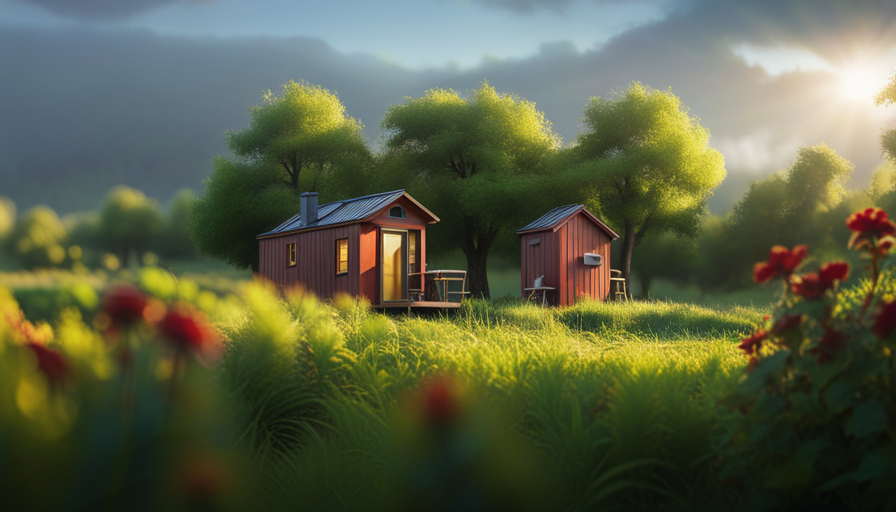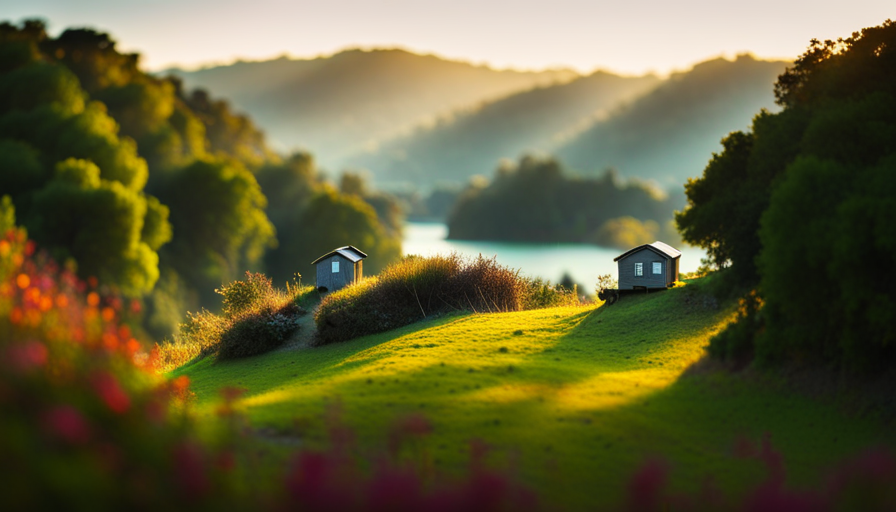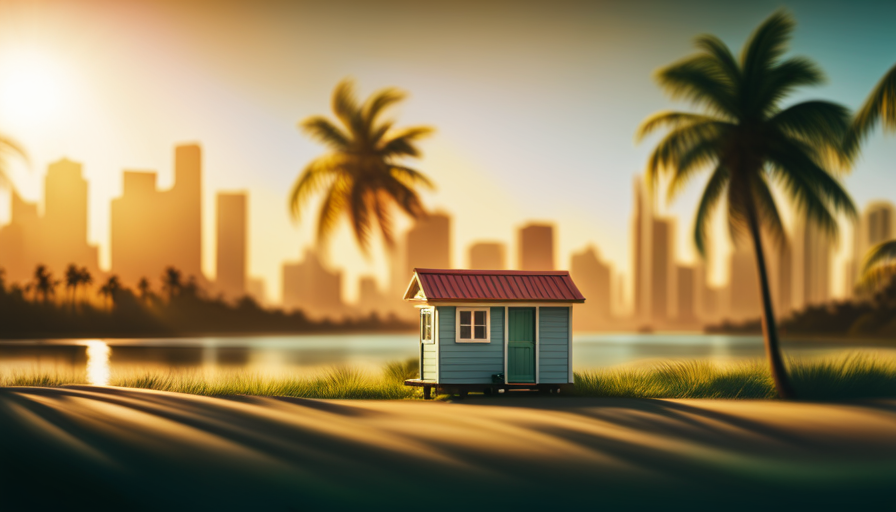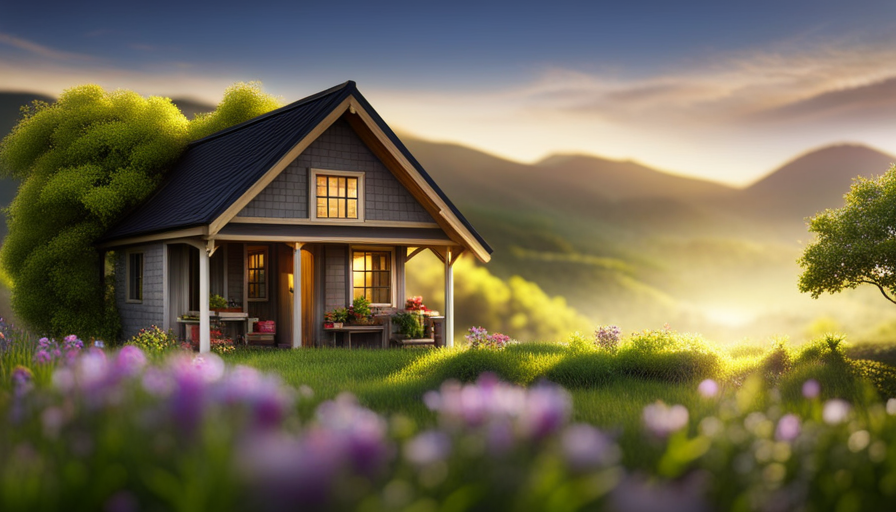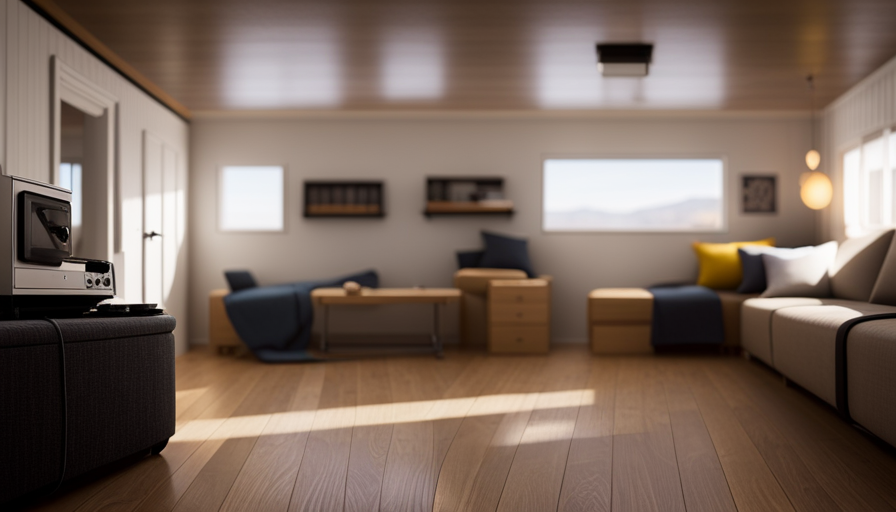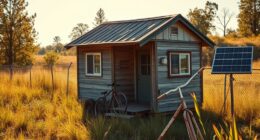I’ve always believed that residing in a tiny house would fulfill one of my greatest dreams. The concept of streamlining my lifestyle, minimizing my environmental impact, and possessing the ability to move freely at a moment’s notice seemed highly attractive. Thus, when I made the decision to purchase my own tiny house, feelings of eagerness and expectation overwhelmed me.
But as I settled into my new home, I couldn’t help but wonder: do most people actually stay when they buy a tiny house?
This question led me on a quest to uncover the truth behind tiny house living. I delved into the benefits of this lifestyle, the challenges that come with it, and the factors that influence people’s decisions to stay or leave. I explored case studies of tiny house owners, learning from their experiences and gathering valuable insights. And through my research, I discovered tips and strategies for making an informed decision about whether to stay or leave.
In this article, I will share my findings and present a data-driven analysis of why people choose to stay or leave their tiny homes. So, if you’re considering the tiny house life or simply curious about the realities of this unique living arrangement, keep reading to find out if most people stay when they buy a tiny house.
Key Takeaways
- Living in a tiny house offers benefits such as cost savings, reduced environmental impact, and a more minimalist lifestyle.
- Factors that influence people’s decision to stay in a tiny house include freedom from excessive belongings, financial savings, and a positive impact on mental health.
- Challenges of living in a tiny house include limited storage space, potential zoning restrictions, and the need to adjust to a minimalistic way of living.
- Personal goals, priorities, and the support of the tiny house community play a significant role in the decision to stay in a tiny house.
Benefits of Tiny House Living
You’ll be amazed at the countless benefits you’ll experience when you choose to live in a tiny house.
There are several pros and cons to consider when deciding whether to downsize your living space.
One of the major advantages of tiny house living is the significant cost savings. Tiny houses are much cheaper to build and maintain compared to traditional homes. Additionally, they typically have lower utility bills and require less furniture and decor.
Another benefit is the reduced environmental impact. Tiny houses use fewer resources and produce less waste, making them a more sustainable housing option.
Furthermore, living in a tiny house promotes a simpler and more minimalist lifestyle, allowing you to focus on experiences rather than material possessions.
However, it’s important to acknowledge the challenges of living in a tiny house, such as limited storage space and potential zoning restrictions.
Despite these challenges, the benefits of tiny house living far outweigh the drawbacks.
Challenges of Living in a Tiny House
Living in a tiny house presents challenges such as limited storage space and a lack of privacy, but can these difficulties be overcome with creative solutions?
Adjusting to limited space can be a daunting task, but with careful planning and organization, it’s possible to make the most of every square inch. Creative storage solutions are key to maximizing the functionality of a tiny house. Utilizing vertical space, incorporating built-in storage units, and investing in multi-purpose furniture are effective ways to optimize storage.
Additionally, finding ways to maintain privacy can be a challenge in a tiny house where rooms are often shared and walls are minimal. However, clever design choices such as using curtains or room dividers can help create private spaces within the tiny home.
Despite these challenges, many individuals find that the benefits of tiny house living outweigh the difficulties, and they choose to stay and embrace this unique lifestyle.
Factors That Influence People’s Decision to Stay
Factors that influence people’s decision to remain in a tiny house include the freedom from excessive belongings and the financial savings that come with a smaller living space. Many individuals find that living in a tiny house allows them to simplify their lives and focus on what truly matters. The limited space forces them to declutter and prioritize their belongings, which can lead to a sense of liberation and reduced stress.
Additionally, the reduced cost of living in a tiny house can contribute to greater financial stability and freedom. The lower expenses for utilities, maintenance, and mortgage payments can allow individuals to save money or pursue other interests and experiences. Furthermore, studies have shown that living in smaller spaces can have a positive impact on mental health, promoting a sense of coziness, security, and comfort.
These factors, along with others, contribute to the longevity of individuals in their tiny homes. Looking ahead, we will explore the reasons people choose to leave their tiny homes.
Reasons People Choose to Leave Their Tiny Homes
There are several key reasons why people choose to leave their tiny homes. One of the main factors is the need for more space or a growing family. As the family grows, the limited space in a tiny home may become insufficient and individuals may decide to seek larger accommodations.
Another significant reason is a change in financial situation. If a person’s financial circumstances improve, they may opt for a larger home that better suits their new lifestyle.
Lastly, some individuals may find it difficult to adjust to the tiny house lifestyle, which can lead them to leave their tiny home and seek alternative housing options.
Need for More Space or Growing Family
If you’re looking to start a family or need more space, buying a tiny house might not be the best option, as the saying goes, "There’s no place like home." While tiny houses offer a unique and minimalist lifestyle, the need for more space or a growing family can pose challenges.
Here are a few reasons why some people choose to leave their tiny homes:
-
Need for downsizing: While downsizing can be liberating, it may not suit everyone in the long run. Some individuals find it difficult to adjust to the limited space and lack of storage options.
-
Financial considerations: Although tiny houses are often more affordable than traditional homes, they still require a significant investment. Some people may find it challenging to keep up with the financial obligations of owning a tiny house.
The need for more space or a growing family can lead some individuals to reconsider their decision to live in a tiny house. However, another factor that can contribute to this change is a shift in financial situation.
Change in Financial Situation
Experiencing a sudden shift in finances can completely alter one’s perspective on living in a tiny house. A change in job or unexpected expenses can create a significant impact on a person’s ability to stay in a tiny house. When faced with a loss of income or increased financial burdens, individuals may find it challenging to maintain their tiny house lifestyle. The financial flexibility that once allowed them to embrace the simplicity and affordability of tiny house living may no longer be feasible.
The need for more space or a growing family may become even more pressing when financial stability is compromised. This change in circumstances can lead to reevaluation and potentially result in individuals leaving their tiny house behind in search of more affordable or practical housing options.
Transitioning from the financial aspect, another difficulty in adjusting to the tiny house lifestyle is…
Difficulty in Adjusting to Tiny House Lifestyle
Adjusting to the tiny house lifestyle can be quite a challenge, as one navigates the endless dance of trying to fit all their belongings into a space the size of a shoebox.
The difficulties in adjusting to this lifestyle are not just physical but also emotional. Many people find it overwhelming to downsize their possessions and adapt to a minimalistic way of living. It can be emotionally challenging to let go of sentimental items and make tough decisions about what to keep and what to discard.
Furthermore, living in a tiny house requires a significant change in daily routines and habits, which can cause additional stress and frustration. These adjusting difficulties can lead some individuals to reconsider their decision to live in a tiny house.
Transitioning now to the subsequent section about case studies of tiny house owners, it is important to explore how individuals have dealt with these challenges.
Case Studies of Tiny House Owners
In examining case studies of tiny house owners, it’s important to consider their success stories and long-term satisfaction. By analyzing data and gathering firsthand accounts, we can gain insights into the factors that contribute to a positive experience with tiny house living.
Additionally, it’s crucial to explore the challenges faced and lessons learned by these individuals, as this information can provide valuable guidance for those considering or currently living in a tiny home.
Success Stories and Long-Term Satisfaction
Imagine yourself living in a tiny house and feeling incredibly satisfied with your decision – many people’ve found long-term success and happiness in their tiny homes.
Success stories abound among tiny house owners, with individuals sharing their experiences of improved financial freedom, reduced environmental impact, and a simpler, more fulfilling lifestyle. A study conducted by the Tiny House Community found that 78% of respondents reported being satisfied with their decision to live in a tiny house for five years or more.
These success stories and long-term satisfaction can be attributed to the careful planning and consideration that goes into the tiny house lifestyle. However, despite these positive outcomes, challenges’re inevitable.
In the subsequent section about challenges faced and lessons learned, we’ll explore some of the hurdles that tiny house owners’ve encountered and how they’ve overcome them.
Challenges Faced and Lessons Learned
Despite the undeniable allure of tiny house living, navigating the challenges and learning valuable lessons along the way is an essential part of the journey towards a more fulfilling and sustainable lifestyle.
Living in a tiny house comes with its fair share of challenges, such as limited storage space, minimal privacy, and the need for constant organization. Additionally, adapting to a smaller living space can be difficult, especially for those who’re used to more spacious accommodations.
However, through these challenges, valuable lessons are learned. One learns the importance of minimalism and the ability to prioritize possessions. It teaches resourcefulness and creativity in finding solutions to maximize space. It also fosters a greater appreciation for the environment and the impact of our choices.
Ultimately, these challenges and lessons shape the decision-making process when considering whether to stay or leave the tiny house lifestyle.
Transitioning into the subsequent section about ‘tips for making a decision to stay or leave,’ it’s essential to reflect on the challenges and lessons learned in order to make an informed choice.
Tips for Making a Decision to Stay or Leave
When deciding whether to stay or leave a tiny house, it’s important to reflect on personal goals and priorities. This includes considering factors such as financial stability, lifestyle preferences, and long-term plans. Seeking support and advice from the tiny house community can provide valuable insights and experiences that can help inform the decision-making process.
Additionally, evaluating the practicality and feasibility of tiny house living is crucial. This involves taking into account factors such as location, available resources, and potential challenges that may arise.
Reflecting on Personal Goals and Priorities
Reflecting on personal goals and priorities, one may wonder if most people stay when they purchase a tiny house. Personal growth and reevaluating priorities often play a significant role in this decision.
Many individuals opt for a tiny house as a way to simplify their lives and focus on what truly matters to them. By downsizing their living space, they can prioritize experiences over material possessions and invest more time in their passions and relationships. However, staying in a tiny house is not always an easy choice. Challenges such as limited space, potential lifestyle adjustments, and the need for ongoing maintenance can arise.
Seeking support and advice from the tiny house community can be beneficial in navigating these challenges and ensuring a successful and fulfilling tiny house experience. Transitioning to the next section, exploring the support available can help individuals make informed decisions about their tiny house journey.
Seeking Support and Advice from Tiny House Community
Seeking support and advice from the tight-knit tiny house community is like entering a world of endless knowledge, where enthusiastic individuals share their ingenious hacks and secrets for thriving in limited space. The tiny house community is a valuable resource for individuals who have just purchased a tiny house and are looking for guidance on how to make the most of their new lifestyle. Whether it’s tips on maximizing storage, innovative space-saving solutions, or advice on off-grid living, the community is always ready to help. In fact, a recent survey of tiny house owners found that 85% of respondents actively sought advice from the community when facing challenges in their tiny house journey. This highlights the importance of community support in ensuring a successful transition to tiny house living. Moving forward, evaluating the practicality and feasibility of tiny house living requires careful consideration of various factors.
Evaluating the Practicality and Feasibility of Tiny House Living
Exploring the practicality and feasibility of living in a tiny house is like embarking on an exciting adventure filled with creative solutions and innovative design.
One of the key considerations when evaluating tiny house living is the environmental impact. With a smaller footprint, these homes often have a reduced impact on the environment compared to traditional houses. From using renewable energy sources to implementing sustainable materials, tiny houses can be designed to minimize their ecological footprint.
Another important aspect to consider is the cost analysis. While the upfront costs of building a tiny house may be lower than buying a conventional home, it’s crucial to take into account ongoing expenses. These include maintenance, utilities, and land rental fees. Conducting a thorough cost analysis will help determine if the financial benefits of tiny house living outweigh the potential challenges.
Furthermore, it’s essential to consider the long-term feasibility of living in a tiny house, taking into account factors such as future family expansion or changing lifestyle needs.
In summary, evaluating the practicality and feasibility of tiny house living requires a comprehensive assessment of both the environmental impact and cost analysis.
Frequently Asked Questions
How much does a tiny house typically cost?
When considering the cost of a tiny house, it’s essential to explore the financing options available.
In terms of a cost comparison, tiny houses generally range from $20,000 to $100,000, depending on factors like size, materials, and customization.
However, it’s important to note that financing a tiny house can be challenging due to their unique nature.
Some people choose to save and pay in cash, while others explore personal loans or RV loans.
Are there any zoning or legal restrictions on where you can park a tiny house?
Zoning restrictions and legal requirements vary depending on the location when it comes to parking a tiny house. Many areas have specific codes that dictate where you can park a tiny house, such as residential zones or designated tiny house communities. Some places may require a building permit or adherence to certain safety standards.
It’s crucial to research local regulations and consult with professionals to ensure compliance with zoning and legal requirements when parking a tiny house.
What are some common misconceptions about living in a tiny house?
Living in a tiny house is not all rainbows and butterflies, despite what some may think. One common misconception is that it’s a carefree and minimalist lifestyle. In reality, there are common challenges such as limited space, lack of storage, and the need for creative organization.
Another misconception is that tiny house living is cheap. While it can be cost-effective, there are still expenses like land, utilities, and maintenance.
It’s important to consider these misconceptions before diving into tiny house living.
What are the potential financial benefits of living in a tiny house?
Living in a tiny house offers numerous financial advantages and cost savings. Firstly, the reduced size means lower construction and maintenance costs.
Additionally, tiny houses often require less energy for heating and cooling, resulting in lower utility bills.
Furthermore, the smaller space encourages a minimalist lifestyle, leading to reduced spending on possessions.
Finally, tiny house owners can potentially avoid or minimize mortgage payments, as many choose to build or buy their tiny houses outright.
How can I ensure that a tiny house will meet my long-term needs and lifestyle?
To ensure that a tiny house meets my long-term needs and lifestyle, I would carefully assess my requirements and preferences.
I would consider factors such as space, amenities, location, and future plans.
Researching and visiting different tiny house models can provide valuable insights.
Additionally, consulting with experts and connecting with tiny house communities can offer valuable advice.
By making an informed decision and considering my long-term goals, I can increase the likelihood of achieving satisfaction and suitability in my tiny house living experience.
Conclusion
In conclusion, while many people are drawn to the idea of living in a tiny house, the decision to stay or leave ultimately depends on individual circumstances and preferences.
Factors such as financial stability, lifestyle adaptability, and access to amenities play a crucial role in determining whether someone will stay in their tiny home.
For example, a case study of a couple who built their tiny house in a remote area but found it challenging to access basic services, ultimately deciding to move to a more urban setting.
Therefore, it’s important for individuals to carefully consider their own needs and priorities before committing to tiny house living.
Hi, I’m Emma. I’m the Editor in Chief of Tiny House 43, a blog all about tiny houses. While tree houses are often associated with childhood, they can be the perfect adult retreat. They offer a cozy space to relax and unwind, surrounded by nature. And since they’re typically built on stilts or raised platforms, they offer stunning views that traditional homes simply can’t match. If you’re looking for a unique and romantic getaway, a tree house tiny house might just be the perfect option.
